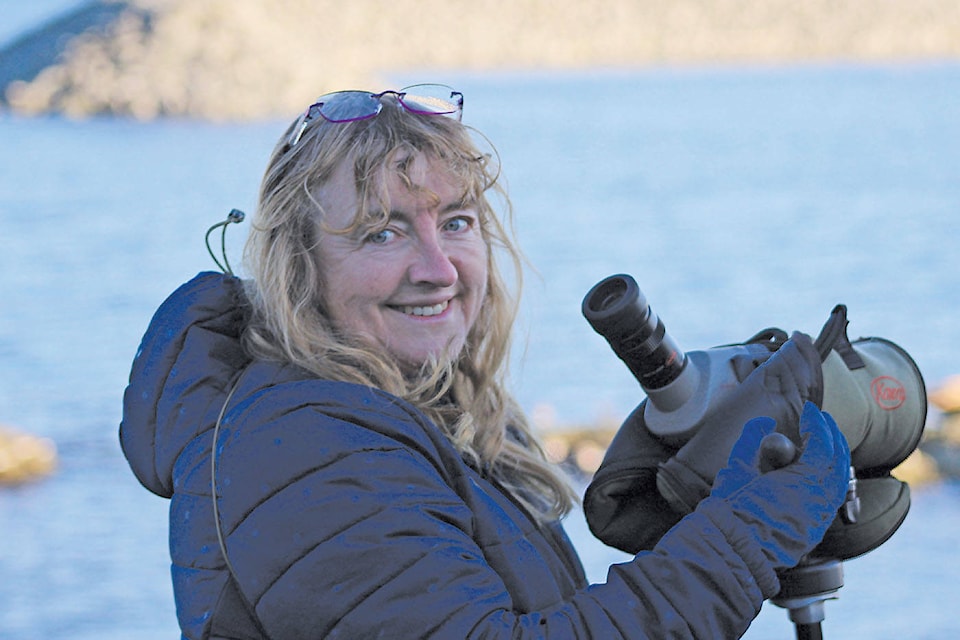Get set for old fashioned tweeting as the annual Christmas Bird Count sets off Saturday.
“There have been some fantastic birds in Oak Bay this week, including a Clark’s Nutcracker last Sunday – a first for Victoria in years – and (Dec. 7), 90 Red Crossbills reported from Uplands Park,” said Ann Nightingale, the appropriately named Victoria Christmas Bird Count co-ordinator.
On Saturday, Dec. 16, more than 200 people, novices to experts are headed to the streets, parks and beaches to count all the birds they can find. The Oak Bay portion of Victoria’s count is led by well-known local birder Geoffrey Newell. Newell guides walks throughout the year, through Friends of Uplands Park and the Capital Regional District.
Other rarities have also been spotted across the region in recent white-winged Crossbills, Pine Grosbeaks, Common Redpolls and a Blue Jay at Ten-mile Point.
While people across the region have noticed high numbers of Steller’s Jays throughout the region, it’s the eastern Blue Jay exciting local birders. “The Christmas Bird Count is really about the local birds,” says Nightingale. “But coming across a rarity is like getting a special present.”
In 2016, teams across the region contributed more than 500 hours, covering more than 1,100 kilometres in their search, and counting a grand total of 73,050 individual birds of 141 species, which was about average for recent years. The species total was the highest of all Canadian counts last year, and the participation of field counters was third highest in North America, surpassed only by Seattle, WA and Oakland, CA.
While many species of birds are seeing declines, one group of birds has been seeing a steady increase – the woodpeckers, especially the Northern Flicker. Nightingale believes this may be due to the effects of climate.
“Many of our fir trees are dying due to drought conditions, setting up the perfect environment for infestations which the woodpeckers love,” Nightingale says. “We know, through reports of birds with coloured bands on their legs, that some of the flickers that winter here nested in the Williams Lake area. Some of the increase in their numbers may be due to the pine beetle infestation providing a good food supply for nesting birds. We won’t know if last summer’s fires will have an effect for a few years.”
While new field counters are always welcome, Nightingale is optimistic that colder weather may also generate more feederwatchers.
“People can contribute by reporting the birds from their own backyards”, she says. She and has produced a brochure with photos of 28 of the most common species they are likely to see around their feeders and gardens.
Anyone can report the birds in their yards or join a field team. For more information, photos of local birds, or to register to participate visit christmasbirdcount.ca or email victoriacbc@naturevictoria.ca.
Potential Oak Bay participants can contact Newell at karatebrothers10@yahoo.ca. Team Oak Bay meets at 8 a.m. on Dec. 16 in the main parking lot at Cattle Point. There will also be a post-count gathering at Scout Hall (505 Marigold) starting at 5 p.m. on count day. This is an open event (whether you have been counting birds or not) where the teams set up their totals and share stories.
The CBC began over a century ago when 27 conservationists in 25 regions, led by scientist and writer Frank Chapman, changed the course of ornithological history. On Christmas Day in 1900, the small group posed an alternative to the “side hunt,” a Christmas day activity in which teams competed to see who could shoot the most birds and small mammals. Instead, Chapman proposed that they identify, count, and record all the birds they saw, founding what is now considered to be the world’s most significant citizen-based conservation effort – and a more than century-old institution.
The CBC is vital in monitoring the status of resident and migratory birds across the Western Hemisphere, and the data, which are 100 per cent volunteer generated, have become a crucial part of Canada’s biodiversity monitoring database.
cvanreeuwyk@oakbaynews.com
Like us on Facebook and follow us on Twitter.
